Effect of Cryogenic Time on Microstructure and Properties of TRCed AZ31 Magnesium Alloy Sheets Rolled during Cryogenic Rolling
Abstract
1. Introduction
2. Material and Methods
2.1. Materials
2.2. Cryogenic Rolling
2.3. Methods for the Characterization of the Microstructure
3. Results and Discussion
3.1. Microstructure Characteristics after Rolling
3.2. Analysis of Mechanical Properties
3.3. Microhardness Analysis
4. Conclusions
- With the increase in cryogenic time, the texture strength of the sheets decreased continuously, and the microstructure uniformity of the sheets increased gradually. The average grain size decreased from 3.98 μm to 2.53 μm. This is mainly because the matrix lattice sequence changes with the extension of cryogenic treatment time, which leads to refining matrix grains. At the same time, the accumulation of strain energy also provides the power and time for dislocation climbing. This results in the formation of sub crystals which contribute to the reduction of average grain size. After the cryogenic treatment, the macrofracture mechanism of the sheet gradually changed from a brittle-fracture to a ductile–brittle mixed-fracture mechanism. These combined effects made the elongation and tensile strength of the cryogenic rolling improve constantly.
- The comprehensive mechanical properties of the AZ31 magnesium alloy sheet were significantly improved with the increase in cryogenic treatment time. When the low-temperature time was 60 s, the performance of the sheet were best. The tensile strength was increased from 282.6 MPa to 305.4 MPa by 8.1%. The yield strength and elongation were increased from 211.4 MPa and 8.2% to 261.14 MPa and 16.3%, respectively, by 23.5% and 98.8%. The overall hardness was remarkably uniform, increasing from 54.6 HV to 62.8 HV. This was mainly because the grain refinement was often accompanied by an increase in strength and hardness, and a decrease in texture strength often led to an increase in elongation. Therefore, compared with the conventional AZ31 preparation method, it is feasible to obtain a sheet with excellent properties by regulating the cryogenic treatment time.
Author Contributions
Funding
Institutional Review Board Statement
Informed Consent Statement
Data Availability Statement
Acknowledgments
Conflicts of Interest
References
- Xu, C.; Nakata, T.; Qiao, X.G.; Jiang, H.S.; Sun, W.T.; Chi, Y.C.; Zheng, M.Y.; Kamado, S. Effect of extrusion parameters on microstructure and mechanical properties of Mg-7.5Gd-2.5Y-3.5Zn-0.9Ca-0.4Zr (wt.%) alloy. Mater. Sci. Eng. A 2017, 685, 159–167. [Google Scholar] [CrossRef]
- Zhang, J.; Huang, H.; Yang, C.B. Effects of hot ring forging on microstructure, texture and mechanical properties of AZ31 magnesium alloy. Mater. Sci. Eng. A 2017, 679, 20–27. [Google Scholar] [CrossRef]
- Liu, D.; Bian, M.Z.; Zhu, S.M.; Chen, W.Z.; Liu, Z.Y.; Wang, E.D.; Nie, J.F. Microstructure and tensile properties of Mg-3Al-1Zn sheets produced by hot roller-cold-material rolling. Mater. Sci. Eng. A 2017, 706, 304–310. [Google Scholar] [CrossRef]
- Pant, R.; Singh, S.; Joshi, A.; Joshi, K.; Saxena, K. Mechanical performance and characteristics evaluation of material through Cryo rolling process: A review. Mater. Today Proc. 2022, 62, 3086–3096. [Google Scholar] [CrossRef]
- Das, P.; Jayaganthan, R.; Singh, I.V. Tensile and impact-toughness behaviour of cryorolled Al 7075 alloy. Mater. Des. 2011, 32, 1298–1305. [Google Scholar] [CrossRef]
- Yu, H.L.; Lu, C.; Tieu, K.; Liu, X.H.; Sun, Y.; Yu, Q.B.; Kong, C. Asymmetric cryorolling for fabrication of nanostructural aluminum sheets. Sci. Rep. 2012, 2, 772. [Google Scholar] [CrossRef]
- Lu, Y.; Ma, R.; Wang, Y.N. Texture evolution and recrystallization behaviors of Cu–Ag alloys subjected to cryogenic rolling. Trans. Nonferrous Met. Soc. China 2015, 25, 2948–2957. [Google Scholar] [CrossRef]
- San, X.Y.; Liang, X.G.; Chen, L.P.; Xia, Z.L.; Zhu, X.K. Influence of stacking fault energy on the mechanical properties in cold-rolling Cu and Cu–Ge alloys. Mater. Sci. Eng. A 2011, 528, 7867–7870. [Google Scholar] [CrossRef]
- San, X.Y.; Liang, X.G.; Cheng, L.P.; Li, C.J.; Zhu, X.K. Temperature effect on mechanical properties of Cu and Cu alloys. Mater. Des. 2012, 35, 480–483. [Google Scholar] [CrossRef]
- San, X.Y.; Liang, X.G.; Cheng, L.P.; Shen, L.; Zhu, X.K. Effect of stacking fault energy on mechanical properties of ultrafine-grain Cu and Cu–Al alloy processed by cold-rolling. Trans. Nonferrous Met. Soc. China 2012, 22, 819–824. [Google Scholar] [CrossRef]
- Wang, L.; Dong, C.F.; Cao, Y.; Liang, J.X.; Li, X.G. Co-enhancing the Mechanical Property and Corrosion Resistance of Selective Laser Melted High-Strength Stainless Steel via Cryogenic Treatment. J. Mater. Eng. Perform. 2020, 29, 7052–7062. [Google Scholar] [CrossRef]
- Ugur, K.; Husnu, K. An Experimental Investigation on Machinability of AZ31B Magnesium Alloy under Dry and Dipped Cryogenic Approaches. J. Mater. Eng. Perform. 2022, 31, 1285–1296. [Google Scholar]
- Huang, Z.Q.; Wei, J.C.; Huang, Q.X.; Ma, L.F.; Yue, Z.H. Effect of Cryogenic Treatment Prior to Rolling on Microstructure and Mechanical Properties of AZ31 Magnesium Alloy. Rare Met. Mater. Eng. 2018, 47, 2942–2948. [Google Scholar]
- Mónica, P.; Bravoa, P.M.; Cárdenas, D. Deep cryogenic treatment of HPDC AZ91 magnesium alloys prior to aging and its influence on alloy microstructure and mechanical properties. J. Mater. Process. Technol. 2017, 239, 297–302. [Google Scholar] [CrossRef]
- Hu, Z.Q.; Guo, C.F.; Li, H.M. Influence of AZ31 sheet treated by cryogenic on punch shearing. J. Cent. South Univ. 2019, 26, 1582–1591. [Google Scholar] [CrossRef]
- Li, J.; Jiang, X.Q. Effect of Cryogenic Treatment on the Microstructure and Mechanical Properties of AZ31 Magnesium Alloy. Mater. Sci. Forum 2011, 686, 53–56. [Google Scholar] [CrossRef]
- Liu, J.W.; Li, G.F.; Chen, D.; Chen, Z.H. Effect of Cryogenic Treatment on Deformation Behavior of As-cast AZ91 Mg Alloy. Chin. J. Aeronaut. 2012, 25, 931–936. [Google Scholar] [CrossRef]
- Che, B.; Lu, L.W.; Zhang, J.L.; Zhang, J.H.; Ma, M.; Wang, L.F.; Qi, F.G. Effects of cryogenic treatment on microstructure and mechanical properties of AZ31 magnesium alloy rolled at different paths. Mater. Sci. Eng. A 2022, 832, 142475. [Google Scholar] [CrossRef]
- Ren, X.W.; Huang, Y.C.; Liu, Y. Cryorolling-Induced Texture, Mechanical Properties and Fracture Behavior of Al-Mg-Si Alloys During Cold Deformation. J. Mater. Eng. Perform. 2018, 27, 3932–3939. [Google Scholar] [CrossRef]
- Zhang, Y.; Ma, J.; Wang, Q.; Yang, Y.B.; Zhu, M.J.; Jia, P.L.; Duan, Y.H.; Zhang, Z.M. Study on anisotropic behavior of 7075 Al alloy after extrusion. Mater. Res. Express 2022, 9, 026508. [Google Scholar] [CrossRef]
- Wang, S.H.; Ma, J.F.; Yang, J.L.; Zhang, W.C.; Sun, Y.P.; Pan, J.Q.; Wang, H.X.; Chen, W.Z. Improving the ductility of Mg-2.5Nd-0.5Zn-0.5Zr alloy by multi-pass hot rolling. J. Mater. Res. Technol. 2021, 14, 2124–2130. [Google Scholar] [CrossRef]
- Zhu, C.; Harrington, T.; Livescu, V.; Gray, G.T.; Vecchio, K.S. Determination of geometrically necessary dislocations in large shear strain localization in aluminum. Acta Mater. 2016, 118, 383–394. [Google Scholar] [CrossRef]
- Wang, P.Y.; Wang, B.Y.; Wang, C.; Wang, J.G.; Wang, H.Y. Design of multicomponent Mg–Al–Zn–Sn–Bi alloys with refined microstructure and enhanced tensile properties. Mater. Sci. Eng. A 2020, 791, 139696. [Google Scholar] [CrossRef]
- Ma, C.Y.; Xia, N.; Wang, C.; Li, M.X.; Hua, Z.M.; Ren, M.W.; Wang, H.Y. A novel Mg-5Al-2Zn-2Sn alloy with high strength-ductility synergy fabricated via simple hot rolling and annealing treatment. J. Alloys Compd. 2021, 869, 159308. [Google Scholar] [CrossRef]
- Ravi Kumar, N.V.; Blandin, J.J.; Desrayaud, C.; Montheillet, F.; Suéry, M. Grain refinement in AZ91 magnesium alloy during thermomechanical processing. Mater. Sci. Eng. A 2003, 359, 150–157. [Google Scholar] [CrossRef]
- Miao, Q.; Zhu, L.T.; Wang, W.K.; Wang, Z.H.; Shao, B.; Chen, W.Z.; Yu, Y.; Zhang, W.C. Evolution of the Microstructure and Mechanical Properties of AZ31 Magnesium Alloy Sheets during Multi-Pass Lowered-Temperature Rolling. Metals 2022, 12, 1811. [Google Scholar] [CrossRef]
- Wu, Z.; Zhi, C.; Ma, L.; Zheng, Z.; Zhu, Y.; Jia, W. Effect of Initial Temperature on the Microstructure and Properties of Cryogenic Rolled Az31 Magnesium Alloy. Mater. Tehnol. 2022, 56, 571–577. [Google Scholar] [CrossRef]
- Wang, T.; Yang, L.; Tang, Z.F.; Wu, L.; Yan, H.Y.; Liu, C.; Ma, Y.Z.; Liu, W.S.; Yu, Z.J. Microstructure, mechanical properties and deformation mechanism of powder metallurgy AZ31 magnesium alloy during rolling. Mater. Sci. Eng. A 2022, 844, 143042. [Google Scholar] [CrossRef]
- Vignesh, P.; Abraham, A.; Kumaran, S. Microstructural correlation of cross rolling temperature of AT55 magnesium alloy in mechanical and formability behaviour. Micron 2022, 160, 103305. [Google Scholar] [CrossRef]
- Ren, X.W.; Huang, Y.C.; Zhang, X.Y.; Li, H.; Zhao, Y.X. Influence of shear deformation during asymmetric rolling on the microstructure, texture, and mechanical properties of the AZ31B magnesium alloy sheet. Mater. Sci. Eng. A 2021, 800, 140306. [Google Scholar] [CrossRef]
- Wang, W.; Chen, W.; Zhang, W.; Cui, G.; Wang, E. Effect of deformation temperature on texture and mechanical properties of ZK60 magnesium alloy sheet rolled by multi-pass lowered-temperature rolling. Mater. Sci. Eng. A 2018, 712, 608–615. [Google Scholar] [CrossRef]
- Liu, D.; Liu, Z.Y.; Wang, E.D. Evolution of twins and texture and its effects on mechanical properties of AZ31 magnesium alloy sheets under different rolling process parameters. Trans. Nonferrous Met. Soc. China 2015, 25, 3585–3594. [Google Scholar] [CrossRef]
- Jiang, Y.; Chen, D.; Jiang, Q. Effect of cryogenic thermocycling treatment on the structure and properties of magnesium alloy AZ91. Met. Sci. Heat Treat. 2012, 53, 589–591. [Google Scholar]
- Wu, C.B.; Kim, S.S.; Park, J.H.; Kim, T.H.; Seo, T.W.; Kim, J.W. Optimization of Design Variables for Minimization of Welding Residual Stress. J. Korean Soc. Manuf. Technol. Eng. 2017, 26, 565–569. [Google Scholar]
- Yadollahpour, M.; Hosseini-Toudeshky, H.; Karimzadeh, F. Effect of Cryorolling and Aging on Fatigue Behavior of Ultrafine-grained Al6061. JOM 2016, 68, 1446–1455. [Google Scholar] [CrossRef]
- Yu, H.; Yan, M.; Li, J.; Godbole, A.; Lu, C.; Tieu, K.; Li, H.; Kong, C. Mechanical properties and microstructure of a Ti-6Al-4V alloy subjected to cold rolling, asymmetric rolling and asymmetric cryorolling. Mater. Sci. Eng. A 2018, 710, 10–16. [Google Scholar] [CrossRef]
- Luo, J.R.; Yan, Y.Q.; Zhang, J.S.; Zhuang, L.Z. Microstructure and mechanical properties of cryorolled AZ31 magnesium alloy sheets with different initial textures. Int. J. Miner. Metall. Mater. 2016, 23, 827–834. [Google Scholar] [CrossRef]
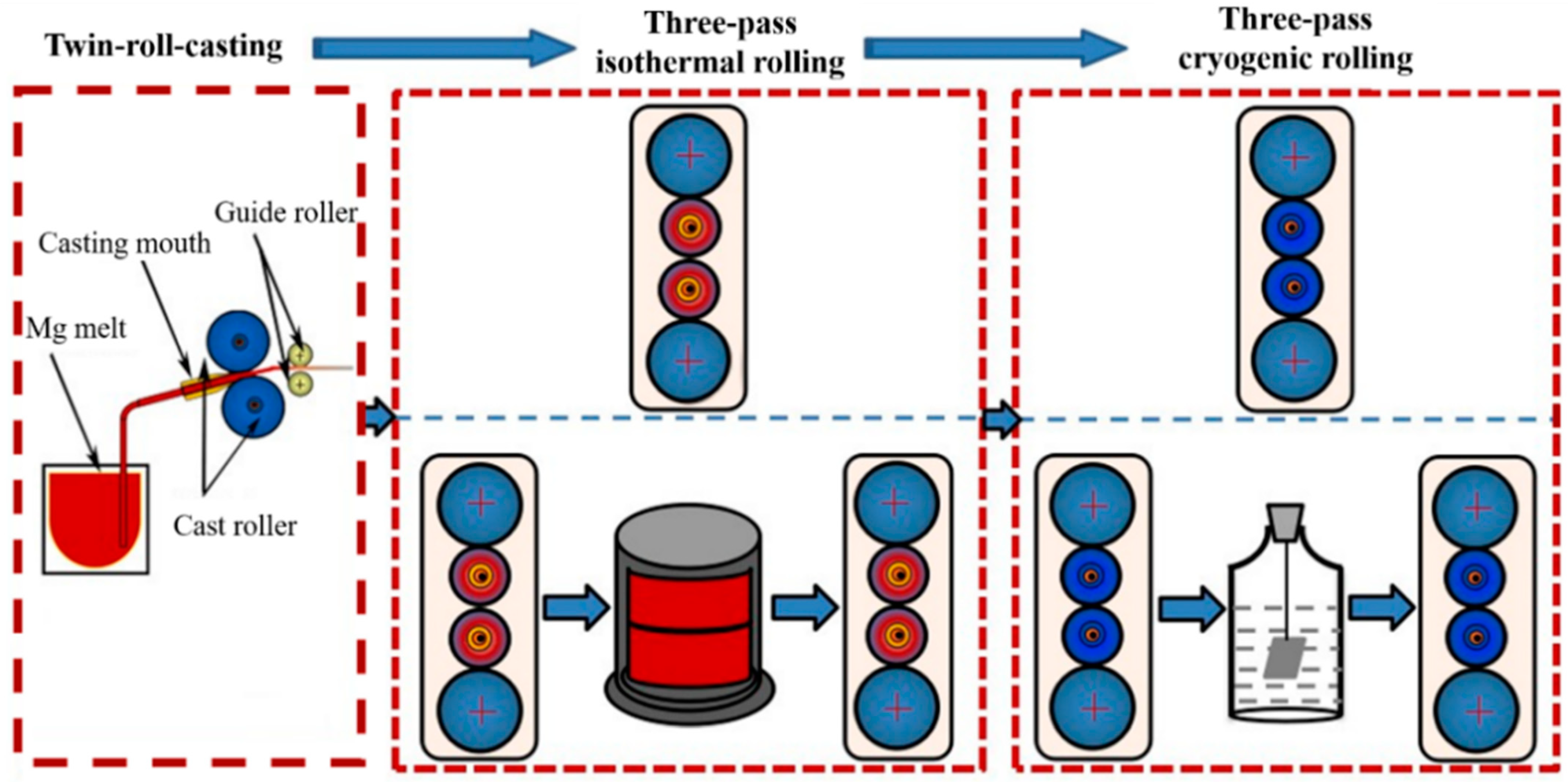
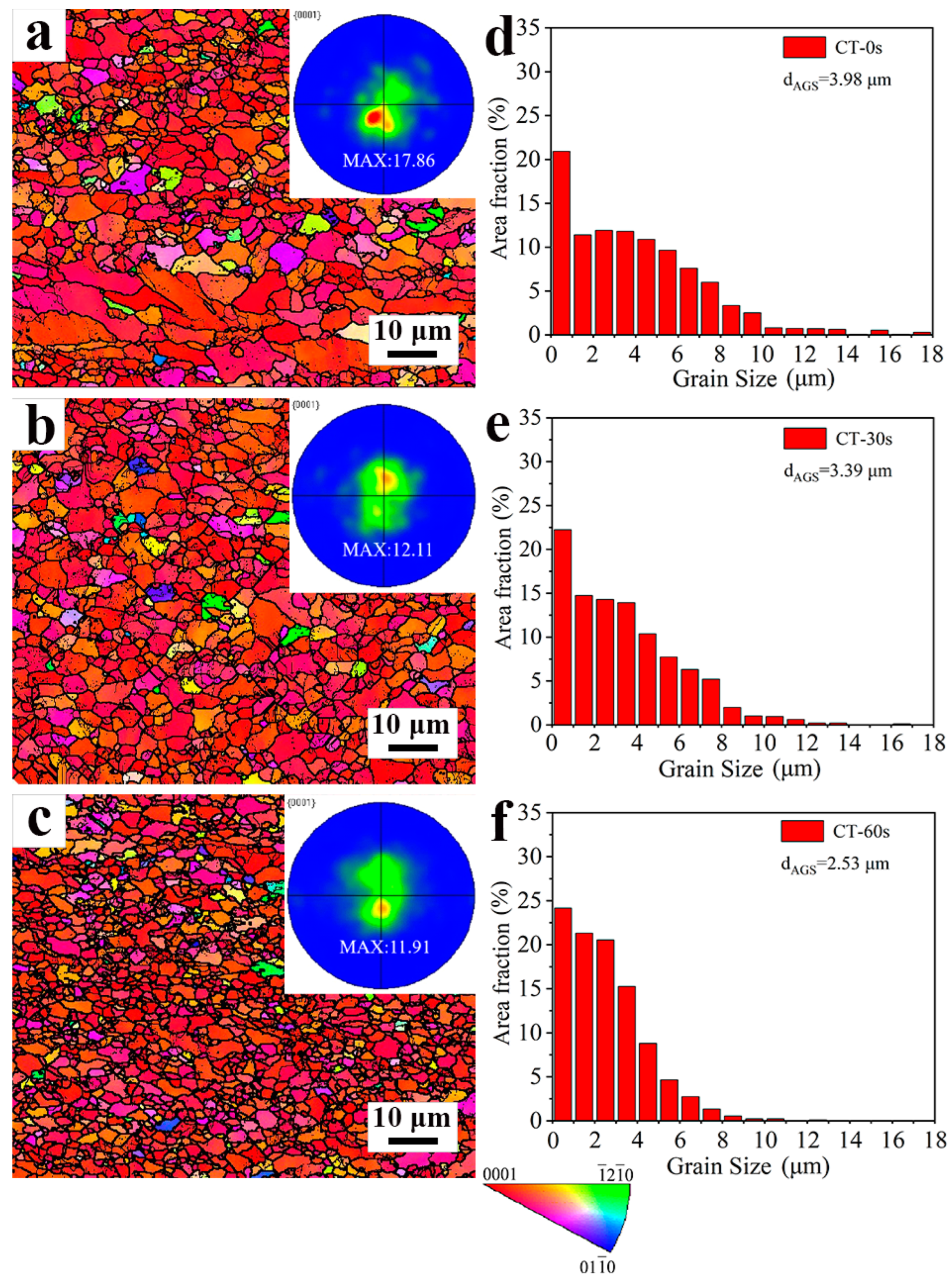
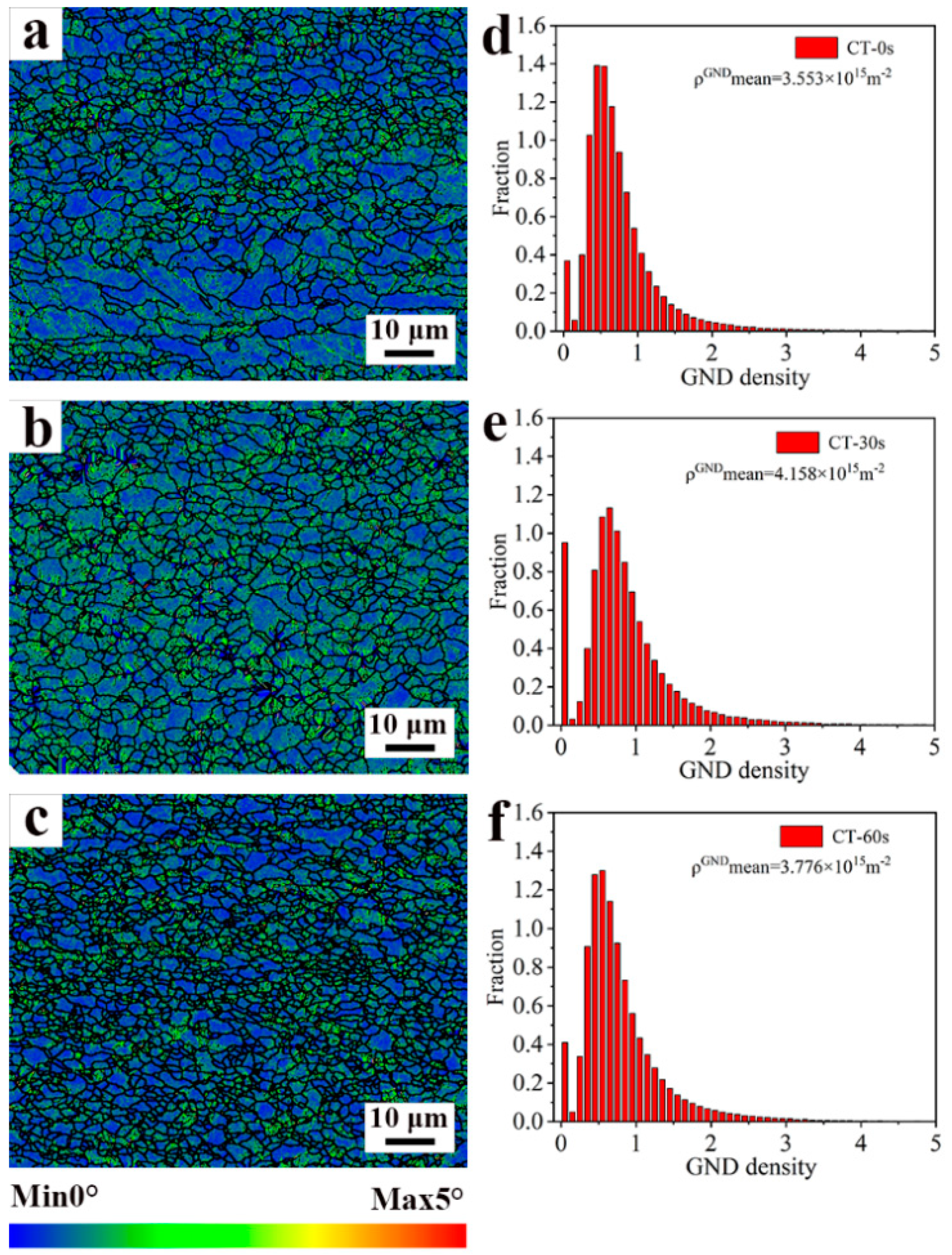
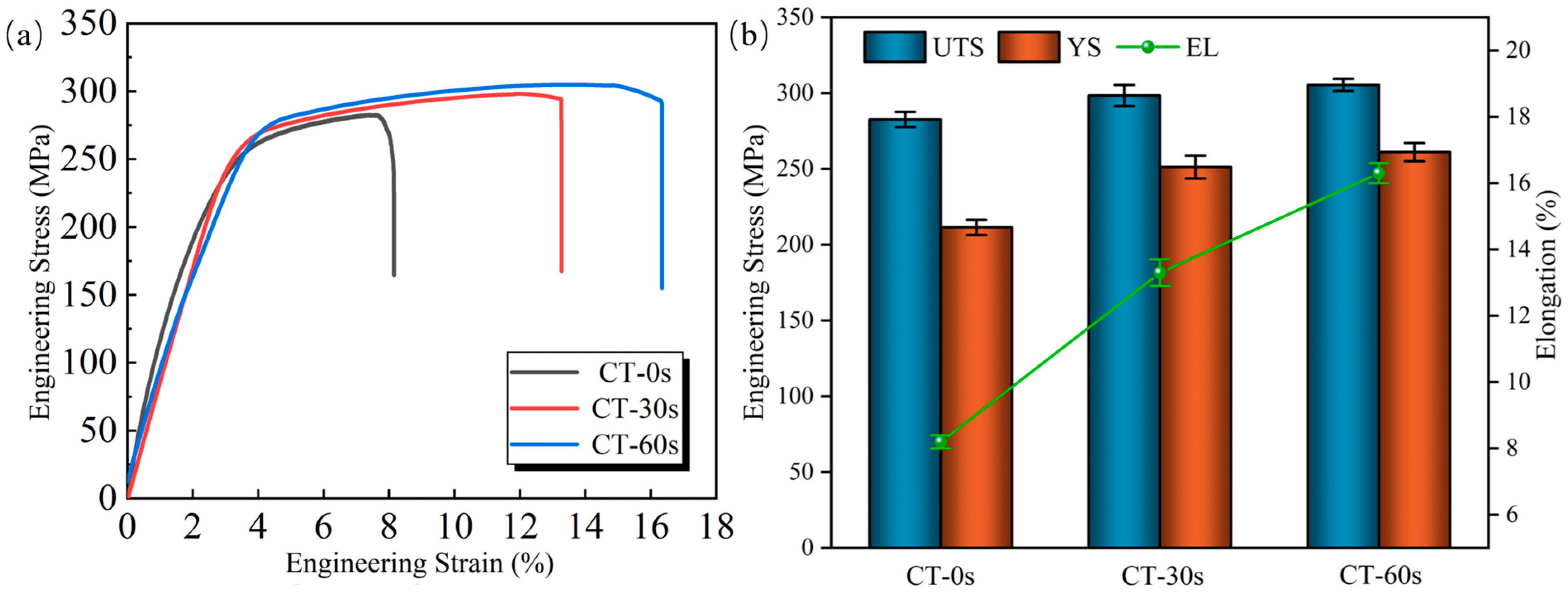
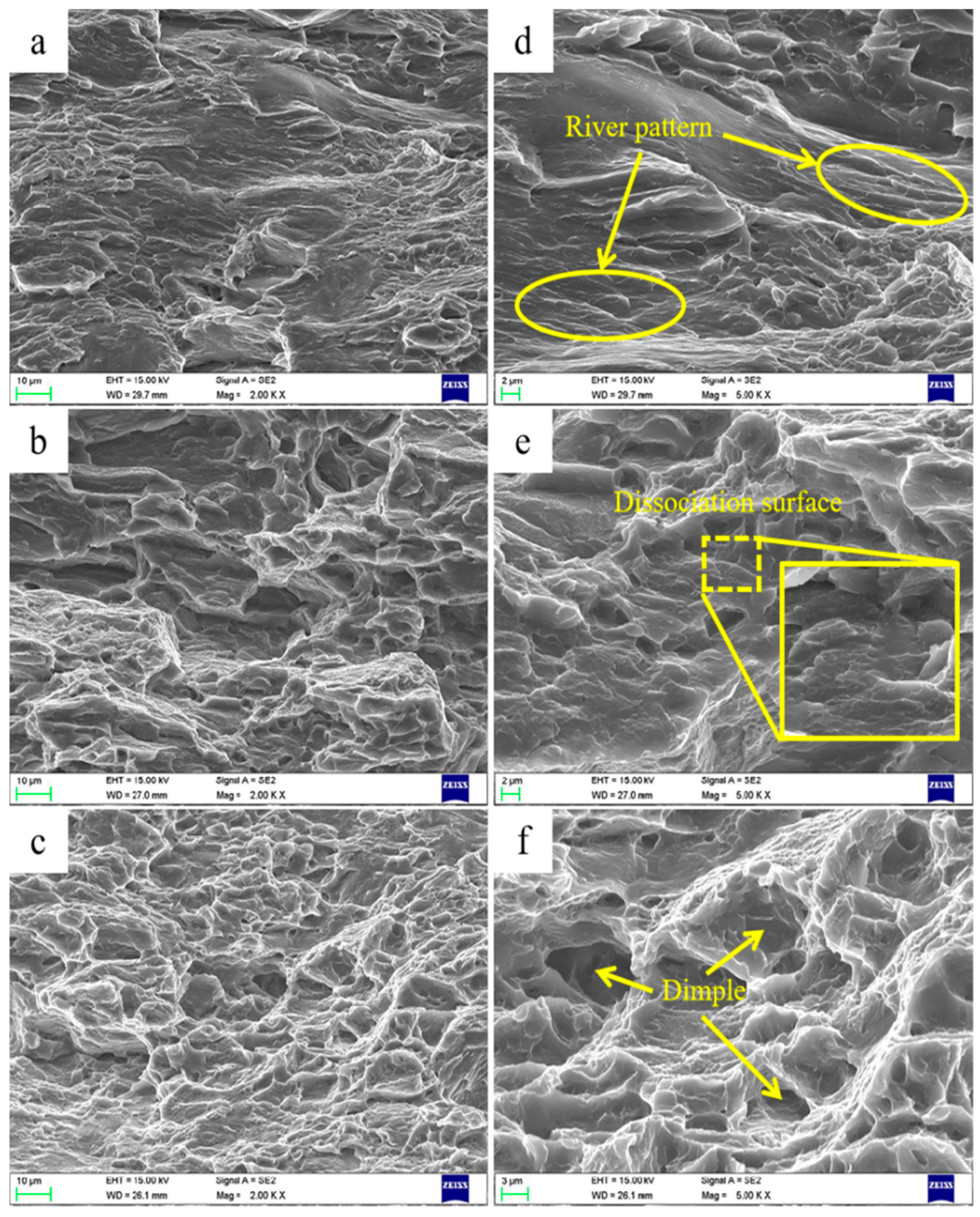

Disclaimer/Publisher’s Note: The statements, opinions and data contained in all publications are solely those of the individual author(s) and contributor(s) and not of MDPI and/or the editor(s). MDPI and/or the editor(s) disclaim responsibility for any injury to people or property resulting from any ideas, methods, instructions or products referred to in the content. |
© 2023 by the authors. Licensee MDPI, Basel, Switzerland. This article is an open access article distributed under the terms and conditions of the Creative Commons Attribution (CC BY) license (https://creativecommons.org/licenses/by/4.0/).
Share and Cite
Zhi, C.-C.; Li, P.-J.; Huang, Z.-Q.; Liu, P.-T.; Xu, H.-J.; Jia, W.-T.; Ma, L.-F. Effect of Cryogenic Time on Microstructure and Properties of TRCed AZ31 Magnesium Alloy Sheets Rolled during Cryogenic Rolling. Metals 2023, 13, 870. https://doi.org/10.3390/met13050870
Zhi C-C, Li P-J, Huang Z-Q, Liu P-T, Xu H-J, Jia W-T, Ma L-F. Effect of Cryogenic Time on Microstructure and Properties of TRCed AZ31 Magnesium Alloy Sheets Rolled during Cryogenic Rolling. Metals. 2023; 13(5):870. https://doi.org/10.3390/met13050870
Chicago/Turabian StyleZhi, Chen-Chen, Pei-Jin Li, Zhi-Quan Huang, Peng-Tao Liu, Hai-Jie Xu, Wei-Tao Jia, and Li-Feng Ma. 2023. "Effect of Cryogenic Time on Microstructure and Properties of TRCed AZ31 Magnesium Alloy Sheets Rolled during Cryogenic Rolling" Metals 13, no. 5: 870. https://doi.org/10.3390/met13050870
APA StyleZhi, C.-C., Li, P.-J., Huang, Z.-Q., Liu, P.-T., Xu, H.-J., Jia, W.-T., & Ma, L.-F. (2023). Effect of Cryogenic Time on Microstructure and Properties of TRCed AZ31 Magnesium Alloy Sheets Rolled during Cryogenic Rolling. Metals, 13(5), 870. https://doi.org/10.3390/met13050870




